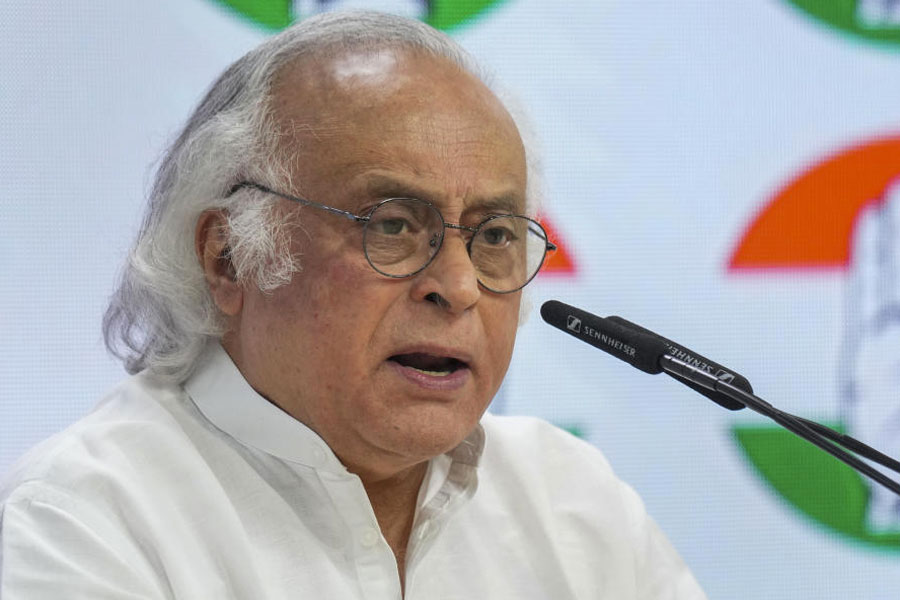|
|
After the conceptual, financial and artistic fiasco of King Lear, the image of the newly-established Minerva Repertory Theatre took such a beating that it retreated into inactivity to rethink its purpose. Gratifyingly, it heeded criticism of its operations and has emerged with a production doing what it should have been doing all along: giving each of its employees enough scope to demonstrate their abundant talents, on the basis of which they had been competitively appointed in the first place. Can we now also ask for a revival of their inaugural abruptly-stopped experimental workshop show so that spectators can see their variety?
For those who unknowingly bewail the supposed dearth of fresh faces in Bengali theatre, Devi Sarpamasta (picture) reveals the next generation, many of them multitaskers — acting, singing and dancing adeptly — guaranteed to shape Calcutta’s dramas of the future. The director, Debesh Chattopadhyay, harnesses their individual abilities to folk-theatre technique remarkably well, except in encouraging an over-the-top acting style that makes the play louder than it needs to be. He should also edit some of the lengthier sequences and musical numbers.
With Manoj Mitra as author, climactic moments are built into the plot anyway, and do not require histrionic embellishment. He places it in a small, Bengal principality just before the British Doctrine of Lapse, when the ruler decides to appease the local Resident with a necklace adorning the patron deity, Sarpamasta. The temple priest regards this as sacrilege, and escapes with it to the mountains, where the tribals recognize it as stolen, belonging to their snake goddess. The priest gets out of this scrape by proclaiming his own daughter as the goddess incarnate. Eventually, the authorities catch up and further romantic complications ensue. As Mitra has often done in other works, he sides with the tribals as the exploited original inhabitants of the land, and clearly wants us to interpret the symbolism for our times, as to who should rightfully inherit the earth.
By far the most bravura performance comes from Anirban Bhattacharya, whose exhausting double role as narrator and hero ensures that he stays on stage nearly right through, singing and acting. Perhaps he could get a break if someone else tells the story. His jester (Prasenjit Bardhan) offers overt shades of greed and trickery. The goddess and her dancer (Ankita Majhi and Mamoni Dasgupta, respectively) impress with their energy, and Sudarshan Chakraborty’s choreography truly electrifies the scenes. Among the hunter community, Loknath Dey commands attention, but all of the forest people fall into the stereotype of depicting villagers as shouters rather than speakers. Nevertheless, every member of the mostly young company has put heart and soul into the unit and they combine smoothly as an ensemble.
Chattopadhyay took the help of folk artists from Birbhum to train the repertory, while Naksha, a group from Gobardanga, has rendered sterling service in studying and applying forms native to its district — Astak and Ram Jatra of Nadia and North 24 Parganas — in its latest production, Bilasibala. Debabrata Das has scripted it around the eponymous woman, a scavenger, who plays the character of Rami, the dhobi’s daughter and widow in Baishnab Padabali, who loves the Brahman Chandidas. Real and stage life coalesce and collide since caste stigmatization continues today, affecting not just Bilasibala but her rural troupe as well.
Bilasibala is unusual not only because it projects the little-known local traditions, including their authentic music played by Debabrata Golder, but also because it showcases that extremely rare phenomenon in Indian theatre — male impersonation. Krishna Adhikari, a regular Rup Kirtan actress, enacts Chandidas. Her performance and singing, and that of Dipanwita Banik Das (Bilasibala/Rami), both in their double parts, are worthy of notice. The director, Ashis Das, successfully fulfils a triple aim: social outreach, stylistic innovation, and documentation of endangered heritage.












